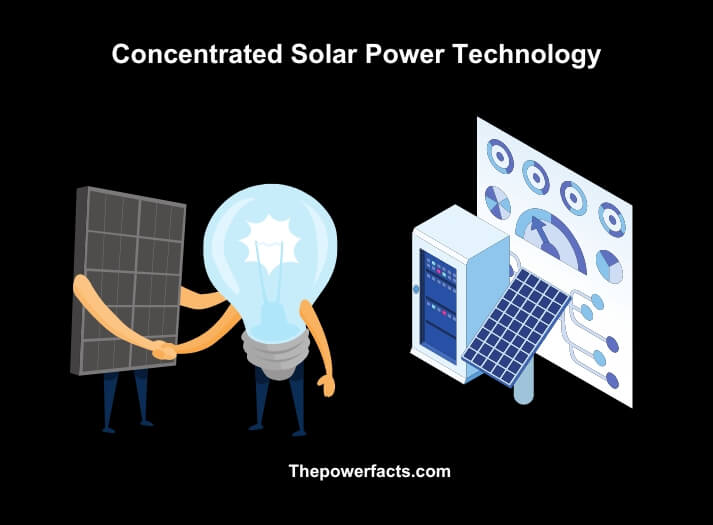Published on: May 2, 2023
Written by Ferris Gregor / Fact-checked by Nova Scarlett
Let’s face it, our planet’s thirst for energy is insatiable. With growing demands, we need to find cleaner, more sustainable ways to power our lives. Enter concentrated solar power technology! It’s a game-changer in the renewable energy sector and is poised to revolutionize the way we harness the sun’s energy. But what exactly is it, and how does it work? Grab your shades, and let’s take a closer look.

A Ray of Hope: The Basics of Concentrated Solar Power Technology
Before we dive into the nitty-gritty, let’s get a quick lay of the land. Concentrated solar power (CSP) technology focuses the sun’s rays to generate heat, which is then used to produce electricity. Unlike solar photovoltaic (PV) systems that directly convert sunlight into electricity, CSP systems utilize mirrors or lenses to concentrate sunlight onto a small area, heating up a fluid that powers a generator to produce electricity.
Types of CSP Systems
CSP technology comes in a variety of flavors, each with its unique set of benefits and challenges. Here are the four main types:
- Parabolic Trough: In this design, curved mirrors focus sunlight onto a linear receiver tube, heating up the fluid inside.
- Linear Fresnel Reflector: This setup utilizes flat or slightly curved mirrors to direct sunlight onto a linear receiver tube atop a tower.
- Power Tower: This system uses a field of mirrors, called heliostats, to concentrate sunlight onto a central receiver at the top of a tall tower.
- Dish-Engine: Resembling a satellite dish, this system focuses sunlight onto a small receiver mounted at the focal point of the dish.
The Pros and Cons of Concentrated Solar Power Technology
While CSP technology offers significant potential, it’s not without its share of challenges. Let’s weigh the pros and cons.
Advantages
- Environmentally friendly: With zero greenhouse gas emissions, CSP is a clean energy source that helps combat climate change.
- Energy storage: CSP systems can store energy in the form of heat, allowing for electricity generation even when the sun isn’t shining.
- Scalability: Large CSP plants can generate electricity on a utility-scale, making it an attractive option for powering entire communities.
Disadvantages
- High initial costs: The upfront costs for constructing CSP plants can be steep, which may deter potential investors.
- Water usage: Some CSP systems use water for cooling, which could pose a challenge in water-scarce regions.
- Land requirements: CSP plants require large tracts of land with direct sunlight, which may not be readily available in certain areas.
Harnessing the Sun’s Potential: Applications of Concentrated Solar Power Technology
From providing electricity to remote areas to producing clean fuels, the potential applications of CSP technology are vast and varied. Here are a few exciting possibilities:
- Off-grid power supply: In remote regions, CSP systems can provide a reliable source of electricity, improving the quality of life for local communities.
- Desalination: CSP technology can power desalination plants, offering a sustainable solution to water scarcity issues in arid regions.
- Hydrogen production: By using CSP-generated heat, water can be split into hydrogen and oxygen, providing a clean fuel source for various applications, such as fuel cells or transportation.
Can Concentrated Solar Power Technology Be Used to Power Kitchen Appliances?
Concentrated solar power (CSP) technology has the potential to revolutionize the kitchen workflow. By harnessing the sun’s energy and converting it into electricity, CSP can power kitchen appliances efficiently. This sustainable energy source can significantly reduce the reliance on traditional power grids, making the kitchen workflow revolution more eco-friendly.
FAQs
How does concentrated solar power technology differ from solar photovoltaic systems?
While both harness the sun’s energy, CSP technology focuses sunlight to generate heat, which is then used to produce electricity. In contrast, solar photovoltaic systems directly convert sunlight into electricity using semiconductor materials.
Can concentrated solar power technology work on cloudy days or at night?
While CSP systems are less efficient on cloudy days, they can store energy in the form of heat, allowing for electricity generation even when the sun isn’t shining. However, they do not function at night.
What are the main challenges of implementing concentrated solar power technology?
Some of the main challenges include high initial costs, water usage in certain systems, and the requirement for large tracts of land with direct sunlight.
Is concentrated solar power technology suitable for residential use?
CSP technology is generally more suited for utility-scale applications rather than residential use, due to the large size and high costs of the systems.
How efficient is concentrated solar power technology?
CSP systems have varying efficiencies depending on the specific technology used. Generally, efficiencies range from 15% to 30%, with newer systems achieving even higher efficiencies.
Conclusion
Concentrated solar power technology holds immense potential in the renewable energy landscape. With its ability to provide clean, sustainable electricity on a large scale, CSP is poised to play a significant role in our transition to a greener future.
Challenges such as high initial costs, water usage, and land requirements must be addressed for CSP technology to reach its full potential. As research and development continue, we can look forward to seeing even more innovative and efficient CSP systems, further solidifying its place as a vital player in the global quest for sustainable energy solutions.
Read more:
